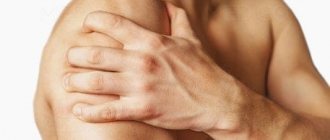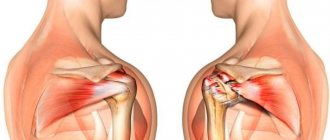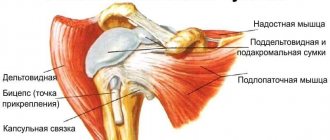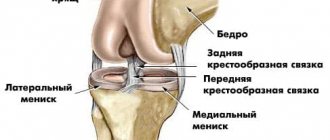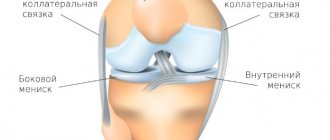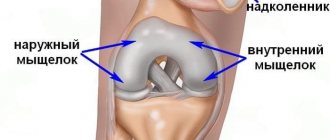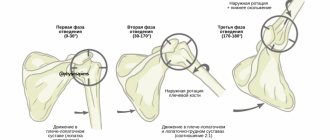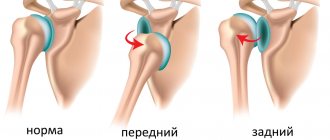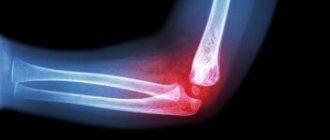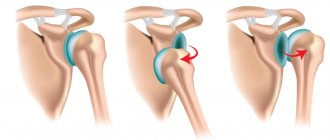The shoulder joint bears a huge physical and functional load. It consists of two main bones: the humerus and the scapula. The humerus, with its head, articulates with the corresponding surface of the scapula (articular process or glenoid). The joint is surrounded by a capsule (articular capsule), ligamentous apparatus, muscle tissue, and is complemented by nerve endings and blood vessels. This is a fairly complex, multifunctional and strong joint that performs movements in large numbers and volume. That is why it is most often subject to dislocations.
What is a habitual shoulder dislocation?
Most often, this type of injury develops as a complication of a normal shoulder dislocation, when you try to straighten it yourself, as well as insufficiently qualified medical care, refusal of surgery, premature start of active physical activity, playing sports, or violation of rehabilitation rules. Damage to nerves and blood vessels is of particular importance during primary dislocation. In this case, the muscles are deprived of proper innervation and blood supply, which is why they begin to weaken. If the dislocation of the shoulder is accompanied by a fracture of any of the bones, then the joint may subsequently become weakly articulated, and as a result, a habitual dislocation is formed.
Causes of habitual shoulder dislocation
- insufficient fixation of the joint after a dislocation;
- errors when setting the bone;
- non-compliance with rehabilitation rules after treatment;
- associated sprain;
- errors in administering anesthesia during treatment;
- muscle weakness;
- unhealed surrounding tissue;
- adhesions, etc.
Additionally, the development of habitual shoulder dislocation is caused by: anomalies in the structure of the bones and the joint itself, physical inactivity, hereditary predisposition, anatomical and physiological features that make bones and muscles vulnerable to the manifestation of this type of injury.
Proper treatment of a dislocation
Treatment for a dislocated shoulder depends a lot on first aid. The dislocation needs to be corrected in the hospital as quickly as possible. Since this injury is often combined with a fracture of the tubercle of the humerus, x-rays are taken before reduction.
The process of bone repositioning is carried out smoothly and gradually. They jerk their hand only in comedy films - in fact, it is very painful and dangerous. There are many important vessels and nerves near the shoulder joint that can be damaged both during a dislocation and during its treatment.
After successful manipulation, the shoulder is fixed with a Deso bandage and a control photograph is taken. Based on the results of the examination, a plan for further treatment and rehabilitation is drawn up. If reduction was performed within the first hours after injury, the results are likely to be satisfactory.
However, in some patients, sufficient shoulder stabilization is not restored. It often “falls out” even for no reason, it begins to hurt, and the entire arm loses its function. In this case, surgical restoration of the joint capsule and ligaments is performed.
Proper rehabilitation after a dislocation
The shoulder joint is a rather “capricious” part of the body. After dislocation, it becomes unstable, but after prolonged fixation it may, on the contrary, lose some of its movements. Proper rehabilitation aims to achieve a balance between immobilization and mobilization of the joint.
The type of retainer matters: wedge-shaped pillow, Deso bandage, scarf bandage. The same weight is also used to support the muscles of the shoulder and forearm during treatment, stimulating capsule regeneration. Of the medical products that most effectively improve joint function, the most important are:
- Needle rollers stimulators. This device can stimulate biologically active points of the shoulder. This enhances the supply of nutrients and nervous regulation of the joint and reduces pain.
- Electromyostimulation. Electrical activation of muscles enhances regeneration, since the main part of the vessels pass through muscle tissue. Additionally, the muscles also play a role in stabilizing the shoulder.
- Manual and electric massagers. Massage of areas adjacent to the joint speeds up the rehabilitation process. Stretch your neck, forearm, and later the shoulder joint itself (very carefully) - swelling and pain will disappear faster.
Medtechnika Orthosalon has the best bandages accepted for the treatment of dislocations (wedge-shaped, scarf, Deso). They are made of hypoallergenic materials, comfortable and reliable, and allow you to take care of your skin. Consultants are ready to suggest the most suitable options for related products - massagers, stimulators, expanders.
Symptoms
Habitual shoulder dislocation usually has its own characteristic manifestations. The main symptom is severe pain. The hand stops moving normally. The joint changes its shape and interferes with the normal functioning and position of the limb. Edema develops quickly. Swollen muscles and displaced bones compress nerve endings and blood vessels. When the shoulder is dislocated, the ligaments supporting the joint become involved in the inflammatory process, weaken and are no longer able to maintain its articulation.
Over time, dislocation will occur from small loads. But it also becomes easier to adjust due to the weakening of the surrounding tissues. The patient experiences pain, but not as severe as with the first injuries. It lasts no more than a day, and then gradually subsides.
If help is not provided in time, dislocations begin to recur regularly. They can happen even due to minor efforts. It will be enough for a person to try to reach somewhere, forcefully throw an object or make a rapid movement, and it will immediately happen. Over time, a habitual dislocation can occur even when trying to comb one's hair, fasten one's clothes, or in an awkward position in sleep.
The shoulder may heal, but the muscle-tendon system will remain deformed. Therefore, with a secondary injury or inadequate load on the limb, dislocation will occur again. Osteoporosis gradually begins to develop in the bones. In this case, it is no longer possible to achieve complete recovery on your own. Surgery required.
What types of shoulder braces are there?
A large load is regularly placed on the shoulders and this leads to negative consequences. The shoulder joint is surrounded on all sides by tendons, ligaments, and muscles, but remains vulnerable to injury. Dislocations or other injuries may occur, which are accompanied by pain, swelling of the entire upper limb, and limited mobility.
The benefits of using a bandage
Repeated injuries cause irreversible damage to the shoulder joint. Even the simplest manipulations with the hand will be difficult to perform in the future. But all these problems can be easily avoided. Injuries should be treated promptly and everything should be done to prevent them. For this purpose, special bandages have been developed that immobilize the clamps. This will keep the shoulder joint in the correct position, minimizing stress, which speeds up the healing process.
The brace intended for the shoulder joint is a universal orthopedic device. With its help, joint mobility is limited after injuries, surgical interventions, and some inflammatory or degenerative diseases. The emphasis is mainly placed not only on partial, but also complete immobilization of the shoulder. Reliable fixation in the correct position allows for faster treatment of joints
, minimize the risk of injury or complication.
When is a shoulder brace needed?
The list of cases when you can use such an orthopedic product is varied. It is effective in the following situations:
- injury;
- stretching;
- tendon rupture;
- injury to the collarbone or scapula;
- fracture;
- the rotator cuff is damaged;
- instability of the shoulder joint.
The bandage can be considered as an alternative to a plaster or bandage bandage, because it is convenient and practical. It is used for the following diseases:
- bursitis;
- arthrosis;
- gout;
- glenohumeral periarthritis;
- adhesive capsulitis.
Type of bandages
They come in the following types:
- For one joint - reinforcing with an elastic sleeve, pressing the limb to the body. Relieves and stabilizes the joint, protects ligaments.
- For two joints - an elastic cape-sleeve, with the help of which two shoulder joints are fixed simultaneously. Often used by athletes to reduce stress and relieve inflammation symptoms.
- Deso bandage – allows you to fix the limb in a suspended position. Suitable for fractures, rehabilitation of bruises, dislocations.
- Shoulder bandage – does not secure the arm in relation to the body. With its help, heat exchange and blood circulation improve.
- Shoulder orthosis - helps fix the limb to the body, with the elbow bent or in a free position. Suitable for cases of fractures and injuries.
Types of shoulder joint fixator
Products differ in purpose, degree of rigidity, and method of fixation. This must be taken into account during selection.
The protective retainer is a short sleeve that connects under the opposite arm. This product is an excellent preventative against sports, household or professional injuries. These types of bandages are characterized by easy fixation. In the future, less stress is placed on the tendons and muscles, which eliminates stretching. An elastic bandage is recommended to be worn for chronic inflammatory diseases and in the postoperative period. Due to moderate compression, blood circulation improves, so swelling goes away faster. Treatment of arthrosis with it
, like other diseases, goes away faster.
A gusset bandage is used to support the arm. It includes a support bag designed for the forearm, an adjustable strap. This model is easily adjustable, which allows you to choose the product to suit your individual body characteristics. It can be used for bruises, fractures, dislocations or other injuries of the upper limb. After fixing the shoulder girdle, the amplitude of movement is limited, and the load is removed from the injured area.
The bandage that limits mobility is in the form of a short sleeve. Due to the flexible straps, the amplitude of shoulder abduction can be adjusted. This model of the product limits movement, creates the effect of dosed compression, which allows you to relieve muscle tension, reduce swelling, and get rid of pain. Suitable for dislocations, fractures, endoprosthetics.
The shoulder girdle orthosis or Deso bandage has a more complex design, which provides fixation of the upper limb. It includes:
- clutch for placing the hand in the desired position;
- belts;
- removable wide belt.
This bandage is widely used for fractures. With its help, the load on the injured limb is reduced, displacement is eliminated, pain is reduced, and recovery occurs faster.
The abductor splint is used to secure the arm in the abducted position. A special pillow is placed between the arm and the body to create the desired abduction angle. This splint is easily secured using waist belts. This product is more suitable for the postoperative period, after endoprosthetics and other types of interventions.
To achieve maximum benefit from the bandage, you should follow the instructions for use.
Some models can be worn around the clock, but the patient’s condition must be taken into account. The cost of orthopedic products depends on the type, quality of the material, and manufacturers. After purchasing, you should consult with a specialist on how to properly put on and use the bandage. Author: K.M.N., Academician of the Russian Academy of Medical Sciences M.A. Bobyr
Treatment methods for habitual shoulder dislocation
As a rule, the patient consults a doctor after a long series of dislocations. Often the symptoms are erased or not noticeable. If a person has already undergone treatment, then a complete medical history can be reconstructed from his existing medical record.
Usually the specialist immediately notices:
- muscle atrophy while maintaining the shape of the joint,
- decreased sensitivity,
- restriction in movement due to fear of recurrent pain,
- caution in using your hand.
Only an experienced traumatologist can diagnose the presence of a habitual dislocation. He will examine the patient, collect anamnesis, and conduct the necessary instrumental studies.
To establish the presence of this type of injury, there are usually four main symptoms:
- Weinstein (limited movement in the forearm);
- Babich (muscles are in spasm, which makes passive movements difficult);
- Khitrova (if you pull the upper limb down, a gap appears between the bone and the articular process of the scapula);
- Stepanova (in the lying position the patient is not able to reach the couch on which he lies).
Additional diagnostic methods include radiography, ultrasound, arthroscopy, electromyography, etc. Good results can be achieved using magnetic resonance and computed tomography. They give a clear picture of all the features of bones, muscles, ligaments, as well as the tissues surrounding them. If necessary, arthrography is performed using contrast. It makes it clear which places are most affected as a result of habitual dislocation.
In the presence of this type of injury, therapeutic treatment is usually not effective, so in most cases surgery is recommended.
If the dislocation occurs a small number of times (no more than two), then it is necessary to wear a fixing bandage. To strengthen the joint, massage and therapeutic exercises are performed. The patient is also prescribed analgesics, external anti-inflammatory drugs, diuretics, wound healing agents, chondroprotectors, calcium supplements, etc.
How to apply an Intex compression bandage for a dislocated shoulder?
To fix the shoulder, use an elastic bandage "Intex" of high or medium elongation, 12 cm wide and 2.5 - 3 m long. 1. Before bandaging, place a cotton wool roll wrapped in gauze into the armpit, then bend the victim’s forearm at a right angle and ask him to press his hand to his chest. 2. Make two fastening tours (that is, rotations) around the chest, the injured arm in the shoulder area, the back and the armpit on the side of the healthy limb. 3. Pass the bandage through the armpit, along the surface of the chest, and along the oblique to the shoulder of the injured side. 4. Pass the bandage down the back of the injured shoulder, under the elbow and around the elbow joint, guiding the bandage through the armpit on the healthy side. 5. Apply the bandage in the direction from the armpit along the back to the sore forearm, and go around it, directing the bandage along the back towards the armpit of the healthy side. Repeat the manipulations until the shoulder is fixed. 6. Complete the dressing with two fixing turns on the chest, sore arm and back, and secure the bandage with clips, which are included in the kit with the Intex bandage.
